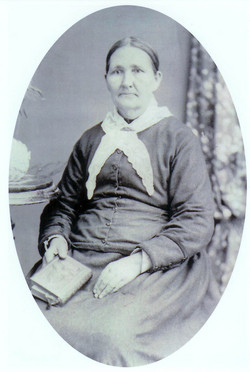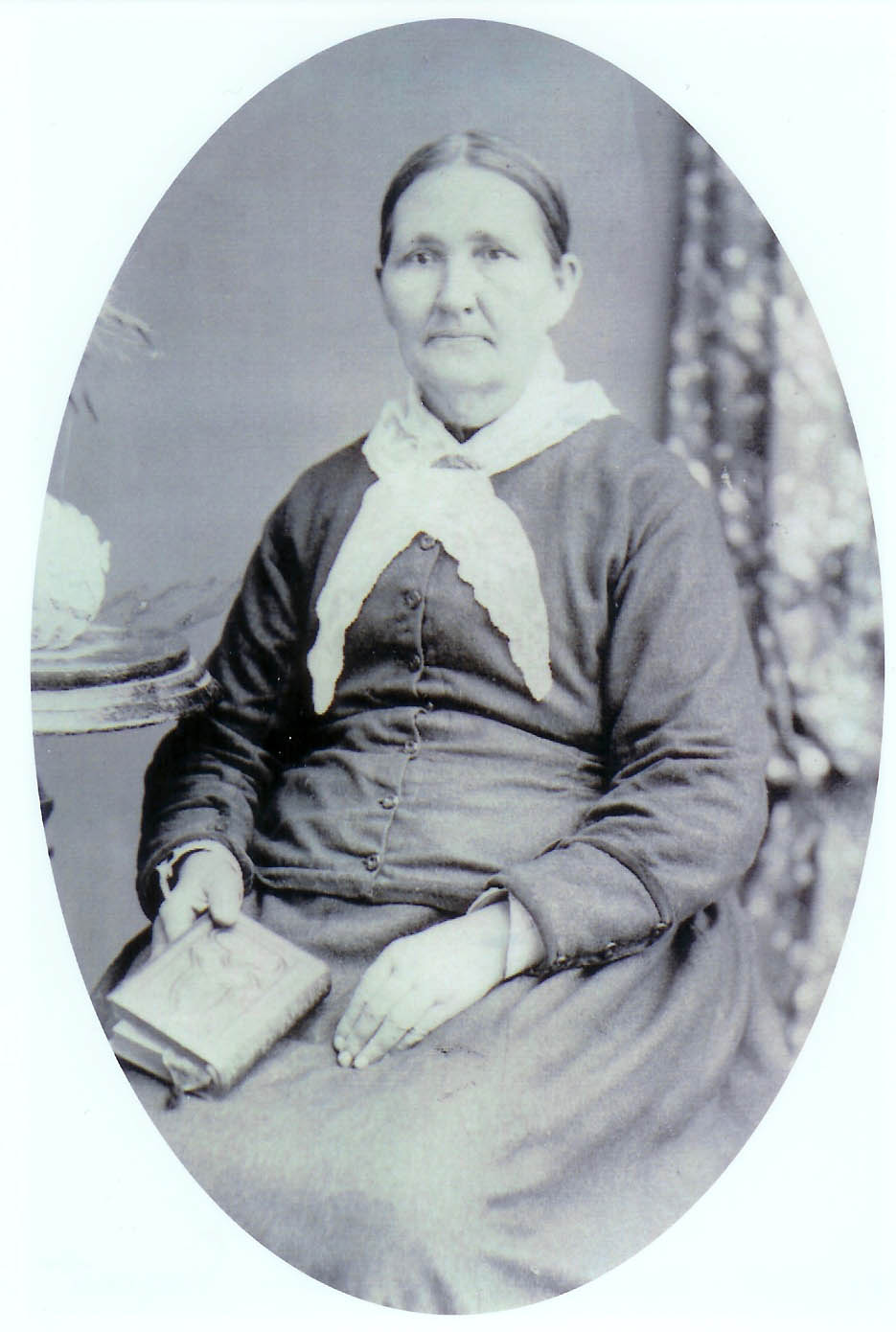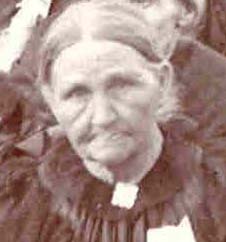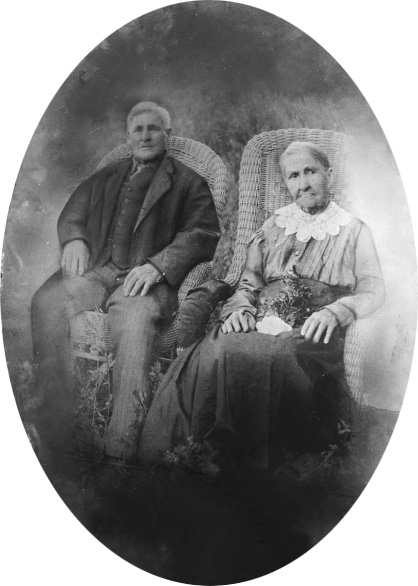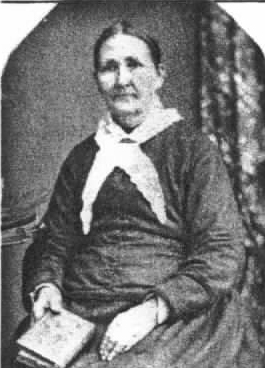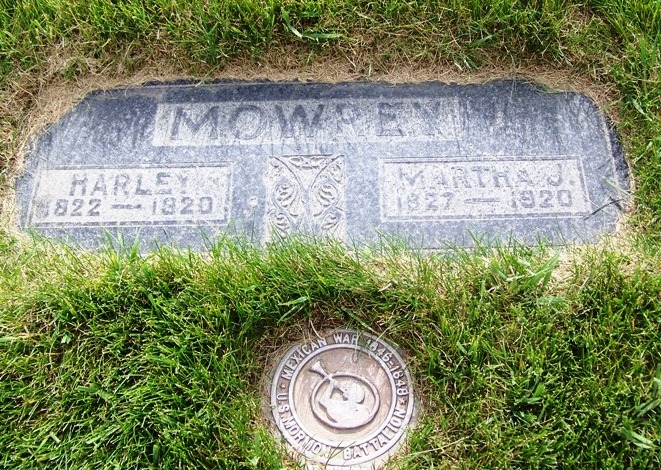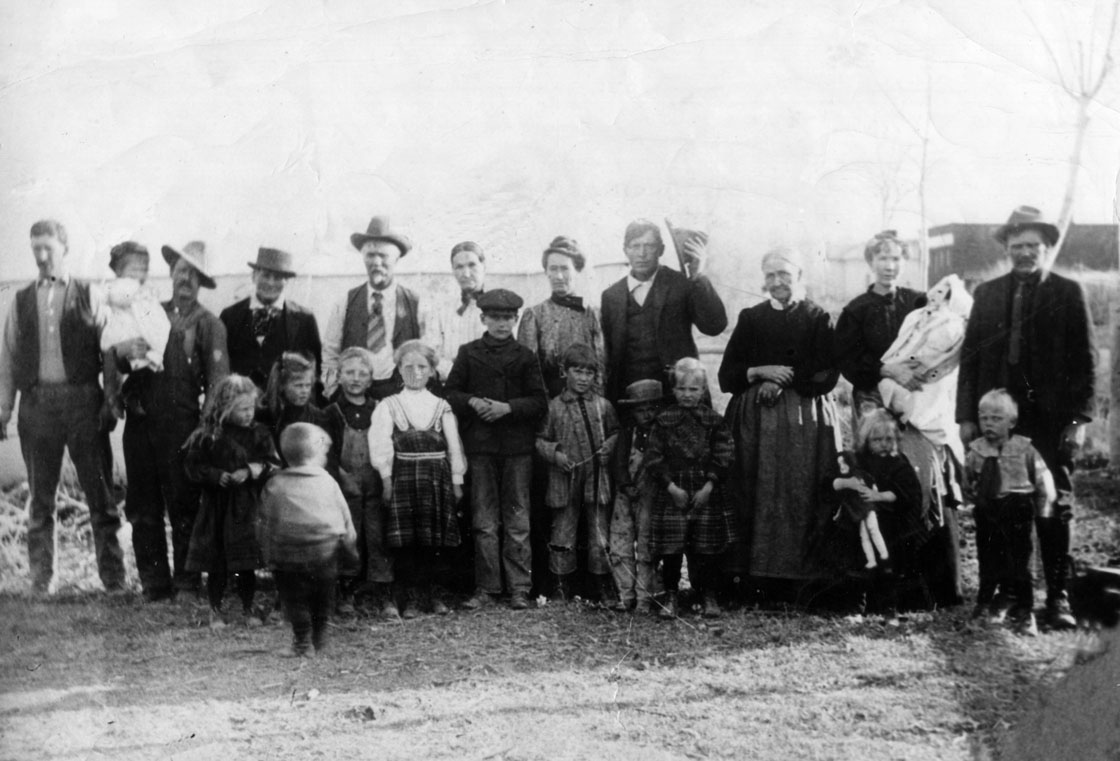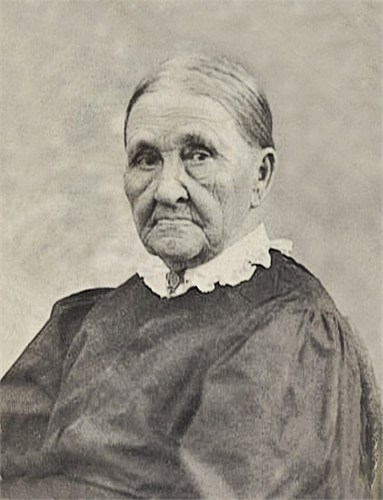A SKETCH OF THE LIFE AND LABORS OF MARTHA JANE SARGENT SHARP MOWREY
Martha Jane S. Mowrey was the daughter of Abel M. Sargent and Sally Edwards Tunis adn was born in Floyd County, Indiana, September 24, 1827. While she was a very small child, her parents became members of the Church of Jesus Christ of Latter Day Saints and gathered with the Saints at the founding of their settlement in Jackson County, Missouri.
Although Martha was very young at the time, she remembered well the gathering of the mob and the experiences of the banishment of the Saints from Jackson County as well as from Clay County, Missouri. While in Clay County, her father had laid a foundation for a comfortable home and raised a splendid crop, but they were forced to leave all this when the mob drove them from their home. The third attempt of her parents to make a home in Missouri was at Far West and even there, they were only privileged to enjoy it for brief time.
Martha Jane was an eye witness to the assembling of 13,000 men, ostensibly a State Militia, but in reality the mobcrats, who had on two former occasions driven, robbed, and plundered the Saints. They camped before the city of Far West and threatened to massacre all the inhabitants fo the city unless the leaders of the church were delivered as prisoners into their hands. She witnessed the arrest of the Prophet Joseph Smith and his associates and saw them carried away, after the leaders of the mob had assured them their prisoners would not be executed.
While at Far West, her father was one of the participants in the battle at Crooked River where Apostle David W. Patten was killed. As the mob had sworn vengence against all who had taken part in the battle, and the whole people had been ordered by Governor Boggs of Missouri to leave the State or be exterminated, Martha's father, with his wife and seven children, left all their earthly possessions and fled over the burned prairie, their bare feet staining their tracks with blood as they traveled.
Not knowing where to seek refuge, their way to Indiana to the home ofher mother's parents, arriving there in destitute circumstances. Soon after their arrival, her mother, being in a delicate and weakened condition as she had recently lost her baby, died from exposure, leaving the children to Martha Jane's care as she was the eldest. Three years later the family gathered again with the body of the Church at Nauvoo, where they resided until the Saints were again driven out in February 1846. Before leaving Nauvoo, Martha married Norman Sharp in September 1845, and in 1846 to them was born one daughter, Sarah Ellen.
During their flight westward from Nauvoo, while stopping at Council Bluffs temporarily, her husband became a member of the Mormon Battalion. She and her sister, Caroline Sargent, accompanied her husband and they were one of the families who attempted to go with the Battalion to California, and were among the little company sent to Pueblo by the Commanding Officer of the Battalion. After this small company, under Captian Higgins, had left the main command, her husband met with a severe accident while he was taking his gun from the wagon. It was accidently discharged, inflicting a severe wound in his arm, so they were unable to travel. At this time, they happened to be near a large body of Araphahoe Indians adn the Indian Chief at once exhibited great hospitality and manged to make them understand that he had a medicine that would cure the wound. As the Captain decided to leave Mr. Sharp in the care of the Indians, but Martha Jane refused to leave her husband there alone and was unalterable in her determination to remain with him, so Captain Higgins consented to leave her, her sister, Caroline Sargent, and Thomas Welsly, a member of the Battalion, with an oxteam and wagon, and the next morning, the company left. Imagine the peril of the situation, the wounded man without the simplest remeby to alleviate the pain, there among savages with whom they could only converse by signs, and chances of saving their lives very much against them. For four long days she watched the wounded man suffer untold agony, and at long last, give up the fight and die. The Indians assisted in the buria without even a rude coffin adn the next morning, the Chief told them to travel fast as there many bad Indians around. This tribe, at the time was at war with the Ute Indians. They traveled almost night and day until they overtook their company and when they met, the women hugged and kissed and her sister wept bitterly as though they were risen from the dead. That winter was spent in Pueblo.
On July 4, 1847, Martha Jane and Harley Mowrey, a member of the escort group from the Battalion, were married at Independence Rock, Wyoming and continued with their group on the trek and arrived in the Salt Lake Valley on July 24, 1847, and from that date, the history of one is virtually the history of the other. Martha Jane's labors in conjunction with her husband as pioneer and colonizer in the states of Utah, California and Idaho, were often related to their children with tearful eyes. How she was compelled in the early days in Utah, to listen helplessly to the pieous cries of her children for food and how they subsisted for food for weeks at a time on roots dug from the earth and sage gathered from the hills in what is now beautiful Salt Lake Valley.
She was a woman of the highest and noblest character, and an active worker in the Church. Her life was adventurous and eventful and even after she had reached the age when most people thought they should lay aside all physical activity, she kept house for her husband. She was 91 and he 97. In the winter, their little house was partly destroyed by fire and they were forced to find shelter the rest of the winter with their daughter, Sarah Ellen Sharp Thomas. They were living at Vernal, Utah, at the time and had resided there for 35 years. She had always befriended the poor and needy, cared for the sick and afflicted, and always been an active worker in Relief Society until her hearing failed her. She was a very sympathetic and loving mother and had ten children, namely: Sarah Ellen Sharp, Angeline Mowrey, Harley Mowrey, Jr., Martha Jane Mowrey, Ruth Caroline Mowrey, Harriet Ann Mowrey, Ella Drucilla Mowrey, Barton Charles Mowrey, Thomas Uriah Mowrey, and David Sargent Mowrey.
At the time of her death, she had 7 of her children still living, 41 grandchildren, 97 great grand children, and 31 great-great grandchildren. She died on 20 Dec. 1920, just two months after the death of her husband, on 10 Oct. 1920. They were buried side-by-side in the Vernal Cemetery. Her husband was the last survivor of the Mormon Battalion -- Harley Mowrey, Sr.
MARTHA JANE SARGENT SHARP MOWREY
Martha Jane Sargent Sharp Mowrey was born in Floyd County, Indiana. While she was a very young child, her parents became members of the Mormon Church and gathered with the Saints in Jackson County, Missouri. Although Martha Jane was very young at the time, she remembered well the gathering of the mobs and the experience of the banishment of the Saints from Jackson County, Clay County and Far West, Missouri. She witnessed the arrest of the Prophet Joseph Smith and other Church leaders. Not knowing where to see refuge, her family made their way to Indiana to the home of her mother's parents, arriving there in destitute circumstances. Soon after their arrival, her mother died from exposure, leaving the children to Martha Jane's care, as she was the eldest.
Three years late, the family gathered again with the body of the Church in Nauvoo, Ill. where they resided until the Saints again were driven out in Feb. 1846. Before leaving Nauvoo, Martha Jane married Norman Sharp in Sept. 1845, and in 1846 to them was born one daughter, Sarah Ellen. During their flight westward from Nauvoo, while stopping at Council Bluffs, Iowa temporarily, her husband became a member of the Mormon Battalion. Martha Jane accompanied her husband to Pueblo, Colorado. Here, he met with a gun accident and died after fourl ong and weary days.
On 4 July 1847, Martha Jane married Harley Mowrey, Sr., at Independence Rock, Wyoming. He was a member of the escort group from the Mormon Battalion. They continued with their group on the trek and arrived in the Salt Lake Valley on 24 July 1847. Martha Jane's labors with her husband as pioneer and colonizer in the states of Utah, California and Idaho were often related to their children with tearful eyes. In the early days in Utah, she had listened helplessly to the piteous cries of her children for food. They subsisted for weeks at a time on roots dug from the earth and sage gathered from the hills of the Salt Lake Valley.
Martha Jane was a woman of the highest and noblest character. She was an active worker in the Church. Her life was adventurous and eventful and even after she had reached the age when most people thoujght she should lay aside all physical activity, she kept house for her husband. She was ninety-one years old and her husband was ninety-seven. One winter, their little home was partly destroyed by fire and they found shelter with their daughter, Sarah Ellen. They lived at Vernal, Utah at the time had had resided there for thirty-five years. Martha Jane always befriended the poor and needy, and cared for the sick and afflicted. She was very sympathetic and loving mother of ten children. She died 20 Dec. 1920, two months after the death of her husband. He was the last survivor of the Mormon Battalion.
OUR PIONEER HERITAGE
VOLUME 1
WOMEN AND CHILDREN OF THE MORMON BATTALION
by Rebecca Smith
On the Fourth of July, 1847, Martha Jane married Harley Mowrey. Martha shared with her husband all the privations and dangers of pioneering in Utah, California, and Idaho. She was a woman of the highest and noblest character and always an active worker in the Church. Her life was adventurous and eventful even after she had reached the age when most people are willing to lay aside many tasks of the day. When she was ninety-one years of age, their little home in Vernal was destroyed by fire. Here they had lived for thirty-five years. She was a sympathetic and loving mother to ten children, three having prceded her in death. Martha passed away two months after her husbands's death in 1920, and they were laid side-by-side in the Vernal Cemetery. - Harriet A. Dingman.
PIONEER WOMEN OF FAITH & FORTITUDE
Martha Jane was born in Floyd County, Indiana. While she was a very young child, her parents became members of the Mormon Church and gathered with the Saints in Jackson County, Missouri. Although Martha Jane was very young at the time, she remembered well the gathering mobs and the experiences of the banishment of the Saints from Jackson County, Clay County and Far West Missouri. She witnessed the arrest of the Prophet Joseph Smith and other Church leaders. Not knowing where to seek refuge, her family made their way to Indiana and the home of her mother's parents, arriving there in destitute circumstances. Soon after their arrival, her mother died from exposure, leaving the children to Martha Jane's care, as she was the eldest.
Three years later, the family gathered again with the body of the Church in Nauvoo, Ill., where they resided until the Saints were again driven out in February 1846. Before leaving Nauvoo, Martha Jane married Norman Sharp in Sept. 1845, and in 1846 to them was born one daughter, Sarah Ellen. During their flight westward from Nauvoo, while stopping at Council Bluffs, Iowa temporarily, her husband became a member of the Mormon Battalion. Marthy Jane accompanied her husband to Pueblo, Colorado. Here, he met with a gun accident and died after four long and weary days.
On July 4, 1847, Martha Jane married Harely Mowrey, Jr., at Independence Rock, Wyoming. He was a member of the escort group from the Mormon Battalion. They continued with their group on the trek and arrived in the Salt Lake Valley 24 July 1847. Martha Jane's labors with her husband as pioneer and colonizer in the states of Utah, California and Idaho were often related to their children with tearful eyes. In the early days in Utah, she listened helplessly to the piteous cries of her children for food. They subsisted for weeks at a time on roots dug from the earth and sage gathered from the hills of the Salt Lake Valley.
Martha Jane was a woman of the highest and nobelest character. She was an active worker in the Church. Her life was adventurous and eventful and even after she had reached an age when most people thought she should lay aside all physical activity she kept house for her husband. She was ninety-one years old and her husband was ninety-seven. One winter their little home was partly destroyed by fire and they found shelter with their daughter, Sarah Ellen. They were living at Vernal, Utah at the time and had resided there for thirty-five years.
Martha Jane always befriended the poor and needy, and cared for the sick and afflicted. She was a very sympathetic and loving mother of ten children. She died 20 December 1920, two months after the death of her husband. He was the last survivor of the Mormon Battalion.
Martha Jane Sargent was born to Abel M. Sargent and Sarah Edwards in Floyd County, Indiana, September 24, 1827.After her mother died in childbirth, Martha was left to care for her younger siblings. After joining the Church, Martha married Norman Sharp in September of 1845. They were driven from their home in Nauvoo and Norman Sharp joinedthe Mormon Battalion at Council Bluffs by encouragement from Brigham Young. Martha and her younger sister Caroline Sargent (about age 10), accompanied the men on the arduous journey. Imagine the untamed West and their feelings asthey traveled with the Mormon Battalion to stop the War with Mexico, waged by the dictator Santa Anna, who had invaded Texas to destroy the Americans there. Imagine being pregnant and marching along with the Mormon Battalion! They went as far as the crossing of the Arkansas River where they were re-assigned to depart with the Higgins Sick Detachment that left for Pueblo, Colorado, in September of 1846. On the way to Pueblo, Private Sharp's gun accidentally discharged as he was taking it from the wagon, inflicting a severe wound to his arm. He was sent back a few miles to a friendly Indian village for treatment. Martha (who was now 6 months pregnant) and her sister, Caroline, refused to leave him, so one of the Mormon Battalion men, a Private ThomasWoolsey remained with them as they fought for his life. "...The medicine man appeared friendly and seemed almostcertain he could cure him in a very few days." However, this did not happen, and Private Norman Sharp died "a stranger in a strange land...." (A Concise History of the Mormon Battalion in the Mexican War" by Daniel Tyler, p165). Private Woolsey and an Indian woman buried him, then Thomas, Martha and Caroline left to catch up to the detachment, wherethey continued on to Pueblo. While at Pueblo, Martha gave birth to a daughter, Sarah Ellen. Martha, Caroline and the baby stayed in Pueblo for the winter, then in May of 1847 left with Capt James Brown's Company (the Missouri Saints) for the Salt Lake Valley. Before arriving in Salt Lake, Martha married Harley Mowrey from Company C on July 4, 1847, at Independence Rock, Wyoming. Martha shared with her husband all the privations and dangers of pioneering in Utah, California, and Idaho. She was awoman of the highest and noblest character and was always an active worker in the Church. Her life was adventurous and eventful. She was the mother of ten children, three of whom preceded her in death. Martha and her husband Harley lived for a number of years in Vernal, Utah, where she passed away on December 20, 1920, at age 93. Tested and tried, true to the faith, her example isworthy to both emulate and honor. We are anxious that Martha Jane, Caroline, Sarah Ellen, andmany other women be remembered and memorialized. We hope to locate the families of these women and share in the joy of honoring their ancestors. This is a program that works, that touches the heart and helps to teach the continuing importance of family and living an honorable life. Margaret Larson
A SKETCH OF THE LIFE AND LABORS OF MARTHA JANE SARGENT SHARP MOWREY
Martha Jane S. Mowrey was the daughter of Abel M. Sargent and Sally Edwards Tunis adn was born in Floyd County, Indiana, September 24, 1827. While she was a very small child, her parents became members of the Church of Jesus Christ of Latter Day Saints and gathered with the Saints at the founding of their settlement in Jackson County, Missouri.
Although Martha was very young at the time, she remembered well the gathering of the mob and the experiences of the banishment of the Saints from Jackson County as well as from Clay County, Missouri. While in Clay County, her father had laid a foundation for a comfortable home and raised a splendid crop, but they were forced to leave all this when the mob drove them from their home. The third attempt of her parents to make a home in Missouri was at Far West and even there, they were only privileged to enjoy it for brief time.
Martha Jane was an eye witness to the assembling of 13,000 men, ostensibly a State Militia, but in reality the mobcrats, who had on two former occasions driven, robbed, and plundered the Saints. They camped before the city of Far West and threatened to massacre all the inhabitants fo the city unless the leaders of the church were delivered as prisoners into their hands. She witnessed the arrest of the Prophet Joseph Smith and his associates and saw them carried away, after the leaders of the mob had assured them their prisoners would not be executed.
While at Far West, her father was one of the participants in the battle at Crooked River where Apostle David W. Patten was killed. As the mob had sworn vengence against all who had taken part in the battle, and the whole people had been ordered by Governor Boggs of Missouri to leave the State or be exterminated, Martha's father, with his wife and seven children, left all their earthly possessions and fled over the burned prairie, their bare feet staining their tracks with blood as they traveled.
Not knowing where to seek refuge, their way to Indiana to the home ofher mother's parents, arriving there in destitute circumstances. Soon after their arrival, her mother, being in a delicate and weakened condition as she had recently lost her baby, died from exposure, leaving the children to Martha Jane's care as she was the eldest. Three years later the family gathered again with the body of the Church at Nauvoo, where they resided until the Saints were again driven out in February 1846. Before leaving Nauvoo, Martha married Norman Sharp in September 1845, and in 1846 to them was born one daughter, Sarah Ellen.
During their flight westward from Nauvoo, while stopping at Council Bluffs temporarily, her husband became a member of the Mormon Battalion. She and her sister, Caroline Sargent, accompanied her husband and they were one of the families who attempted to go with the Battalion to California, and were among the little company sent to Pueblo by the Commanding Officer of the Battalion. After this small company, under Captian Higgins, had left the main command, her husband met with a severe accident while he was taking his gun from the wagon. It was accidently discharged, inflicting a severe wound in his arm, so they were unable to travel. At this time, they happened to be near a large body of Araphahoe Indians adn the Indian Chief at once exhibited great hospitality and manged to make them understand that he had a medicine that would cure the wound. As the Captain decided to leave Mr. Sharp in the care of the Indians, but Martha Jane refused to leave her husband there alone and was unalterable in her determination to remain with him, so Captain Higgins consented to leave her, her sister, Caroline Sargent, and Thomas Welsly, a member of the Battalion, with an oxteam and wagon, and the next morning, the company left. Imagine the peril of the situation, the wounded man without the simplest remeby to alleviate the pain, there among savages with whom they could only converse by signs, and chances of saving their lives very much against them. For four long days she watched the wounded man suffer untold agony, and at long last, give up the fight and die. The Indians assisted in the buria without even a rude coffin adn the next morning, the Chief told them to travel fast as there many bad Indians around. This tribe, at the time was at war with the Ute Indians. They traveled almost night and day until they overtook their company and when they met, the women hugged and kissed and her sister wept bitterly as though they were risen from the dead. That winter was spent in Pueblo.
On July 4, 1847, Martha Jane and Harley Mowrey, a member of the escort group from the Battalion, were married at Independence Rock, Wyoming and continued with their group on the trek and arrived in the Salt Lake Valley on July 24, 1847, and from that date, the history of one is virtually the history of the other. Martha Jane's labors in conjunction with her husband as pioneer and colonizer in the states of Utah, California and Idaho, were often related to their children with tearful eyes. How she was compelled in the early days in Utah, to listen helplessly to the pieous cries of her children for food and how they subsisted for food for weeks at a time on roots dug from the earth and sage gathered from the hills in what is now beautiful Salt Lake Valley.
She was a woman of the highest and noblest character, and an active worker in the Church. Her life was adventurous and eventful and even after she had reached the age when most people thought they should lay aside all physical activity, she kept house for her husband. She was 91 and he 97. In the winter, their little house was partly destroyed by fire and they were forced to find shelter the rest of the winter with their daughter, Sarah Ellen Sharp Thomas. They were living at Vernal, Utah, at the time and had resided there for 35 years. She had always befriended the poor and needy, cared for the sick and afflicted, and always been an active worker in Relief Society until her hearing failed her. She was a very sympathetic and loving mother and had ten children, namely: Sarah Ellen Sharp, Angeline Mowrey, Harley Mowrey, Jr., Martha Jane Mowrey, Ruth Caroline Mowrey, Harriet Ann Mowrey, Ella Drucilla Mowrey, Barton Charles Mowrey, Thomas Uriah Mowrey, and David Sargent Mowrey.
At the time of her death, she had 7 of her children still living, 41 grandchildren, 97 great grand children, and 31 great-great grandchildren. She died on 20 Dec. 1920, just two months after the death of her husband, on 10 Oct. 1920. They were buried side-by-side in the Vernal Cemetery. Her husband was the last survivor of the Mormon Battalion -- Harley Mowrey, Sr.
MARTHA JANE SARGENT SHARP MOWREY
Martha Jane Sargent Sharp Mowrey was born in Floyd County, Indiana. While she was a very young child, her parents became members of the Mormon Church and gathered with the Saints in Jackson County, Missouri. Although Martha Jane was very young at the time, she remembered well the gathering of the mobs and the experience of the banishment of the Saints from Jackson County, Clay County and Far West, Missouri. She witnessed the arrest of the Prophet Joseph Smith and other Church leaders. Not knowing where to see refuge, her family made their way to Indiana to the home of her mother's parents, arriving there in destitute circumstances. Soon after their arrival, her mother died from exposure, leaving the children to Martha Jane's care, as she was the eldest.
Three years late, the family gathered again with the body of the Church in Nauvoo, Ill. where they resided until the Saints again were driven out in Feb. 1846. Before leaving Nauvoo, Martha Jane married Norman Sharp in Sept. 1845, and in 1846 to them was born one daughter, Sarah Ellen. During their flight westward from Nauvoo, while stopping at Council Bluffs, Iowa temporarily, her husband became a member of the Mormon Battalion. Martha Jane accompanied her husband to Pueblo, Colorado. Here, he met with a gun accident and died after fourl ong and weary days.
On 4 July 1847, Martha Jane married Harley Mowrey, Sr., at Independence Rock, Wyoming. He was a member of the escort group from the Mormon Battalion. They continued with their group on the trek and arrived in the Salt Lake Valley on 24 July 1847. Martha Jane's labors with her husband as pioneer and colonizer in the states of Utah, California and Idaho were often related to their children with tearful eyes. In the early days in Utah, she had listened helplessly to the piteous cries of her children for food. They subsisted for weeks at a time on roots dug from the earth and sage gathered from the hills of the Salt Lake Valley.
Martha Jane was a woman of the highest and noblest character. She was an active worker in the Church. Her life was adventurous and eventful and even after she had reached the age when most people thoujght she should lay aside all physical activity, she kept house for her husband. She was ninety-one years old and her husband was ninety-seven. One winter, their little home was partly destroyed by fire and they found shelter with their daughter, Sarah Ellen. They lived at Vernal, Utah at the time had had resided there for thirty-five years. Martha Jane always befriended the poor and needy, and cared for the sick and afflicted. She was very sympathetic and loving mother of ten children. She died 20 Dec. 1920, two months after the death of her husband. He was the last survivor of the Mormon Battalion.
OUR PIONEER HERITAGE
VOLUME 1
WOMEN AND CHILDREN OF THE MORMON BATTALION
by Rebecca Smith
On the Fourth of July, 1847, Martha Jane married Harley Mowrey. Martha shared with her husband all the privations and dangers of pioneering in Utah, California, and Idaho. She was a woman of the highest and noblest character and always an active worker in the Church. Her life was adventurous and eventful even after she had reached the age when most people are willing to lay aside many tasks of the day. When she was ninety-one years of age, their little home in Vernal was destroyed by fire. Here they had lived for thirty-five years. She was a sympathetic and loving mother to ten children, three having prceded her in death. Martha passed away two months after her husbands's death in 1920, and they were laid side-by-side in the Vernal Cemetery. - Harriet A. Dingman.
PIONEER WOMEN OF FAITH & FORTITUDE
Martha Jane was born in Floyd County, Indiana. While she was a very young child, her parents became members of the Mormon Church and gathered with the Saints in Jackson County, Missouri. Although Martha Jane was very young at the time, she remembered well the gathering mobs and the experiences of the banishment of the Saints from Jackson County, Clay County and Far West Missouri. She witnessed the arrest of the Prophet Joseph Smith and other Church leaders. Not knowing where to seek refuge, her family made their way to Indiana and the home of her mother's parents, arriving there in destitute circumstances. Soon after their arrival, her mother died from exposure, leaving the children to Martha Jane's care, as she was the eldest.
Three years later, the family gathered again with the body of the Church in Nauvoo, Ill., where they resided until the Saints were again driven out in February 1846. Before leaving Nauvoo, Martha Jane married Norman Sharp in Sept. 1845, and in 1846 to them was born one daughter, Sarah Ellen. During their flight westward from Nauvoo, while stopping at Council Bluffs, Iowa temporarily, her husband became a member of the Mormon Battalion. Marthy Jane accompanied her husband to Pueblo, Colorado. Here, he met with a gun accident and died after four long and weary days.
On July 4, 1847, Martha Jane married Harely Mowrey, Jr., at Independence Rock, Wyoming. He was a member of the escort group from the Mormon Battalion. They continued with their group on the trek and arrived in the Salt Lake Valley 24 July 1847. Martha Jane's labors with her husband as pioneer and colonizer in the states of Utah, California and Idaho were often related to their children with tearful eyes. In the early days in Utah, she listened helplessly to the piteous cries of her children for food. They subsisted for weeks at a time on roots dug from the earth and sage gathered from the hills of the Salt Lake Valley.
Martha Jane was a woman of the highest and nobelest character. She was an active worker in the Church. Her life was adventurous and eventful and even after she had reached an age when most people thought she should lay aside all physical activity she kept house for her husband. She was ninety-one years old and her husband was ninety-seven. One winter their little home was partly destroyed by fire and they found shelter with their daughter, Sarah Ellen. They were living at Vernal, Utah at the time and had resided there for thirty-five years.
Martha Jane always befriended the poor and needy, and cared for the sick and afflicted. She was a very sympathetic and loving mother of ten children. She died 20 December 1920, two months after the death of her husband. He was the last survivor of the Mormon Battalion.
Martha Jane Sargent was born to Abel M. Sargent and Sarah Edwards in Floyd County, Indiana, September 24, 1827.After her mother died in childbirth, Martha was left to care for her younger siblings. After joining the Church, Martha married Norman Sharp in September of 1845. They were driven from their home in Nauvoo and Norman Sharp joinedthe Mormon Battalion at Council Bluffs by encouragement from Brigham Young. Martha and her younger sister Caroline Sargent (about age 10), accompanied the men on the arduous journey. Imagine the untamed West and their feelings asthey traveled with the Mormon Battalion to stop the War with Mexico, waged by the dictator Santa Anna, who had invaded Texas to destroy the Americans there. Imagine being pregnant and marching along with the Mormon Battalion! They went as far as the crossing of the Arkansas River where they were re-assigned to depart with the Higgins Sick Detachment that left for Pueblo, Colorado, in September of 1846. On the way to Pueblo, Private Sharp's gun accidentally discharged as he was taking it from the wagon, inflicting a severe wound to his arm. He was sent back a few miles to a friendly Indian village for treatment. Martha (who was now 6 months pregnant) and her sister, Caroline, refused to leave him, so one of the Mormon Battalion men, a Private ThomasWoolsey remained with them as they fought for his life. "...The medicine man appeared friendly and seemed almostcertain he could cure him in a very few days." However, this did not happen, and Private Norman Sharp died "a stranger in a strange land...." (A Concise History of the Mormon Battalion in the Mexican War" by Daniel Tyler, p165). Private Woolsey and an Indian woman buried him, then Thomas, Martha and Caroline left to catch up to the detachment, wherethey continued on to Pueblo. While at Pueblo, Martha gave birth to a daughter, Sarah Ellen. Martha, Caroline and the baby stayed in Pueblo for the winter, then in May of 1847 left with Capt James Brown's Company (the Missouri Saints) for the Salt Lake Valley. Before arriving in Salt Lake, Martha married Harley Mowrey from Company C on July 4, 1847, at Independence Rock, Wyoming. Martha shared with her husband all the privations and dangers of pioneering in Utah, California, and Idaho. She was awoman of the highest and noblest character and was always an active worker in the Church. Her life was adventurous and eventful. She was the mother of ten children, three of whom preceded her in death. Martha and her husband Harley lived for a number of years in Vernal, Utah, where she passed away on December 20, 1920, at age 93. Tested and tried, true to the faith, her example isworthy to both emulate and honor. We are anxious that Martha Jane, Caroline, Sarah Ellen, andmany other women be remembered and memorialized. We hope to locate the families of these women and share in the joy of honoring their ancestors. This is a program that works, that touches the heart and helps to teach the continuing importance of family and living an honorable life. Margaret Larson
Family Members
-
![]()
Sarah Ellen Sharp-Mowrey Thomas
1846–1937
-
Angeline Mowrey
1848–1864
-
![]()
Harley Mowrey Jr
1851–1921
-
Martha Jane Mowrey
1855–1855
-
![]()
Ruth Caroline Mowrey Hansen
1856–1938
-
![]()
Harriet Anne "Hattie" Mowrey
1858–1942
-
Ellen Drucilla Mowrey Dingman
1861–1953
-
![]()
Charles Barton Mowrey
1866–1957
-
![]()
Uriah Mowrey
1869–1952
-
![]()
Thomas Uriah Mowrey
1869–1952
-
David Sargent Mowrey
1872–1889
